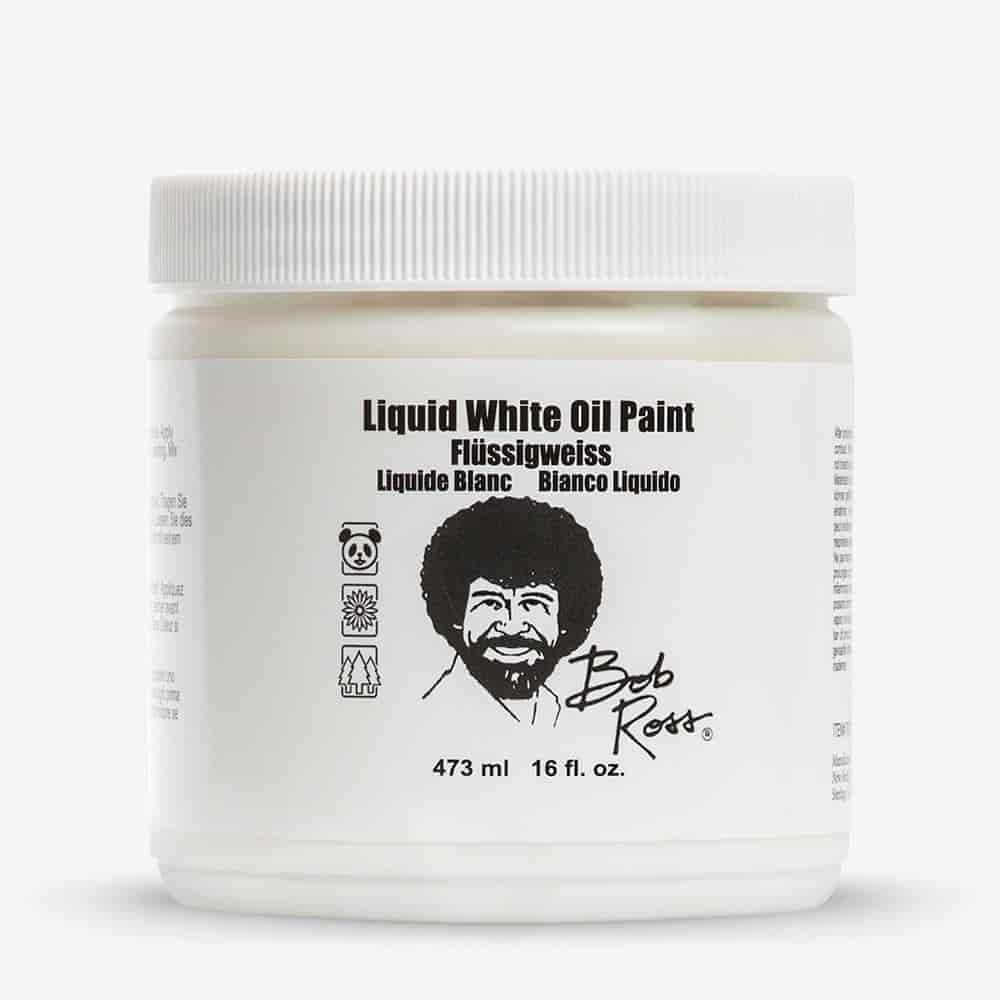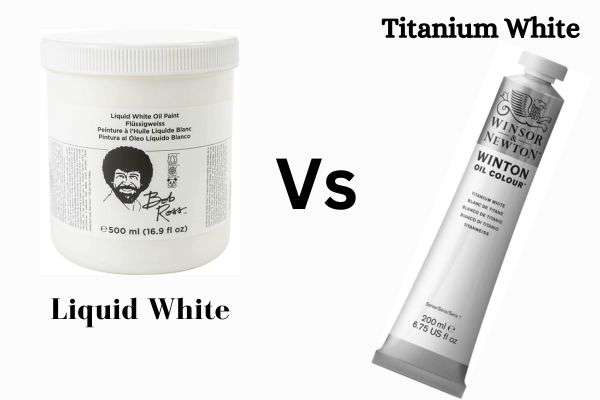In oil painting, liquid white has its own separate place in the minds of artists due to its stunning results. It can also be mixed with other colors to enhance visibility, performance, and texture. Beginners often get confused when they see liquid white and titanium white together.
In this blog, we will discuss thoroughly liquid white vs titanium white and at the end of this blog, you will be able to differentiate between these two materials and their characteristics as well. Let’s start!
Table of Contents
- Liquid white as a substitute for titanium white
- Titanium white as a substitute for liquid white
- What happened when you mix Liquid white and titanium white?
- Which is better?
- FAQs
- Final Words
Liquid White vs Titanium white
Liquid White was introduced by Bob Ross in his 1980s Television show. It is an oil painting medium that increases the texture and drying time to help in blending. On the other hand, titanium white is a pure white pigment that is popular due to its brightness and ability to create highlights.
Note: Titanium white can create liquid white but liquid white cannot be a substitute for titanium white.
In deeper words, liquid white is specifically an oil painting medium that is mostly used by artists to create blending effects in their artworks. It was introduced by a famous artist named Bob Ross who used this medium in his television show to create amazing effects. It is a thin and white colored mixture of titanium white and linseed oil that is applied to the canvas before applying brush strokes. The main purpose of liquid white is to create soft, smooth, and gentle transitions with a wet-on-wet technique. It can also be used to create light effects on the canvas.
On the other hand, titanium white is a popular white color pigment that is known for its bright and white shade. In the world of paint, titanium white is like a king of pigments that is opaque, bright, durable, and has high covering power. It can be obtained by grinding titanium dioxide into a powder form. Liquid white is just used in oil painting while titanium white is used in watercolors, acrylics, oils, and other mediums as well. It also has a good ability to fade over time when it comes in contact with light which can help to differentiate it from liquid white.
Read Also: Liquid white vs Gesso?
Affiliate Disclaimer!
This section contains some products with affiliate links. Buying through our links won’t cost you extra charges but we may receive some commission. Know more about our Review Policy here.
Recommended Liquid White

Bob Ross Liquid White 473ml
- Quality ingredients
- Professional results
- Formulated for the wet-on-wet technique
- Multi-colors
- Amazon’s Choice
About Bob Ross Liquid White
Bob Ross liquid white comes in a 437 ml plastic jar with the branding of the logo of Bob Ross and his signs. As this magical white liquid was started by Bob Ross, so this brand specifically uses the techniques of Bon Ross to manufacture this magical white. It is best for both indoor and outdoor painting. For best results, use it for oil painting only.
At the time of publishing, Bob Ross liquid white had a total of 1700 ratings with an average of 4.7 stars out of 5. It is essential to create a background blend without any additional effort. It also dries at a faster rate when it is put on very sparingly.
Additional Features:
Brand: Bob Ross | Color: White | Size: 16.9 fl oz | Volume: 500 ml | Paint type: Oil
Price at the time of publishing: 20.99$
Our Ratings: 5 Out of 5
What We Like!
- Value for money
- Bob Ross technique
- Amazon’s Choice
- Professional results
What We Don’t Like!
- Strong linseed oil smell
Recommended Titanium White

Winsor & Newton Winton Oil Color, 200ml (6.75-oz) Tube, Titanium White
- Chip resistant
- Professional quality
- Satin finish
- Smooth
About Winsor & Newton Titanium White
Winsor & Newton Titanium White comes in a 6.75 oz metallic tube with the branding of Winsor & Newton. This moderate level of titanium white can be used for both educational and professional use. It also has a transparency capacity of O level. It has a special quality of chip resistance that is better than normal and requires less preparation.
At the time of publishing, the product had a total of 14431 ratings with an average of 4.8 stars out of 5. There is no doubt that no other oil pigment can provide such quality in this price range and we especially recommend it to all beginners and professionals.
Additional Features:
Brand: Winsor & Newton | Color: titanium White | Finish type: Satin | Size: 6.75 fl-oz | Item Volume: 200 Millileters
Price at the time of publishing: 20.06$
Our Ratings: 5 Out of 5
What We Like!
- Professional Quality
- Performance in this price range
- Smoothness
- Brand popularity
What We Don’t Like!
- There is nothing to dislike
Liquid white as a substitute for titanium white
To understand this term, first, we need to clear the purpose of both these materials. Here is a table showing the properties and workings of liquid white and titanium white.
| Properties | Liquid White | Titanium White |
| Consistency | Thin and fluid | Like many of the other colors |
| Compatibility | Oils | All |
| Surface | Slick | Bright |
| Reflectivity | Yes | Yes |
| Drying time | Slow | Moderate |
The table clearly stated that liquid white is compatible just with oils which means it cannot be used for any other medium. Well, if someone wanted to use liquid white as a substitute for titanium white, he should not use any other pigments above a wet surface of liquid white because it contains an additional amount of linseed oil that will blend the other colors and will not leave a specific effect of titanium white. To avoid any kind of unwanted results, it is recommended to spend some effort to arrange a titanium white.
Titanium white as a substitute for liquid white
Titanium white can be used as a substitute for liquid white if an additional amount of linseed oil is added to the white pigment. As the table above shows that titanium white can be used for all painting mediums especially oils so we just need to keep in mind that magic white is also titanium white but it just contains some additional amount of lined oil.
Read: How to create liquid white at home?
To create liquid white, take 50 grams of titanium white in a jar and add 50 grams of linseed oil to it. Mix the solution very well. Your magic white is ready to use.
What happened when you mix Liquid white and titanium white?
As titanium white is known as white pigment but every white pigment is not titanium white. There are other pigments such as zinc white but it is quite interesting to know what will happen when liquid white and titanium white will be mixed together. Well, their liquid white is thinner in consistency due to the presence of linseed oil but other materials will be in the form of jelly-like consistency.
Mixing both will result in creating a creamy paste-like mixture thicker than liquid white but not flowy. It could be used to create some special shading effects and it will also tend to create a little bit of blending effects. We can also say it is a hybrid mixture of liquid white and titanium white.
Which is better?
There are artists who love to create a blending effect and use white in their paintings to enhance its b beauty but on another side, some artists are comfortable using only titanium white to create their oil paintings. No doubt, both have their own ways but is it possible that any of the materials always create better artwork? Well, liquid white is just a medium of another level because the blending effects are just awesome to see. It is also hard to find an artist with exceptional skills to do the blending. Most of the artists can use titanium white but there are few who can do blending.
FAQs
What is white called in art?
In art, white is used for a pigment that is colorless such as titanium white or zinc white. This white is usually made by crushing titanium white into a powder-like form. White can be referred for chalk as well in art but in painting, white is referred for the colorless pigment.
What is another name for liquid white?
Another name for liquid white is Magic white or liquid clear.
Final Words
In oil painting, magic white and titanium white are two essential components with their own unique properties and purposes. White pigment is just a gift to this world by nature, including any of the white pigments used in art. It is used in the creation of other pigments as well. Titanium white is a widely used pigment that is famous for its brightness, and versatility across different painting mediums. On the other hand, magic white, popularized by the name of Bob Ross is a more opaque, thinner, and softer paint that is used for blending effects.
The choice between both of these mediums depends upon the artist and the technique they are using to paint. Liquid white is just used in oil painting but other medium is useable for all the techniques.
Read More:
